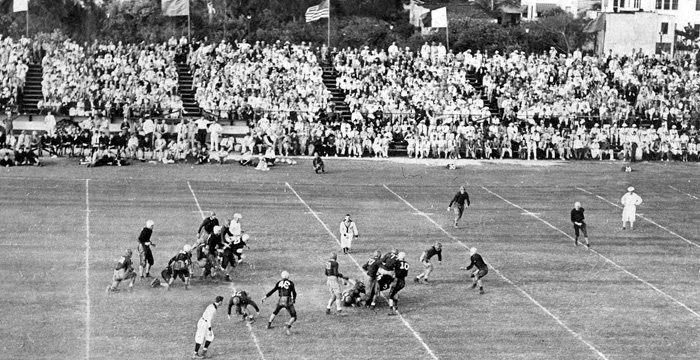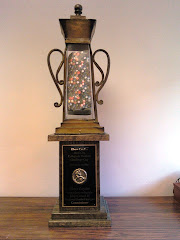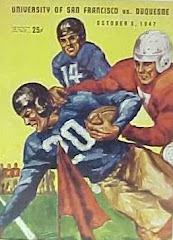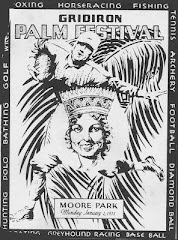No kidding- The Massey Ratings rank the 1941 Dukes the #1 Major College Football Team in the Nation. That team went 8-0 and was one of three undefeated, untied teams in the nation that year along with Duke and Minnesota. They gave up only 21 points all season to lead the nation in scoring defense, rushing defense and total defense. The AP ranked the Dukes #8 that year. See these links-
Many recognized collegiate football ranking systems begin declaring national champions dating back to 1869 when Princeton was declared national champion by most systems. Controversy exists even in that year’s selection of the nation’s best by some systems rating Rutgers at the top. Back then there were no polls taken by sports writers such as the AP Top 25 or the USA Today Poll or the now defunct UPI Coaches Poll.
The most familiar and accepted current system, The Associated Press only released their first collegiate football ranking in 1934. No AP Poll was released in 1935 but they have been releasing continuous rankings since 1936. The only inconsistency with the AP Poll since 1936 relates to the years when they would not issue a final yearly ranking after the college bowl games.
College football teams from 1869 to the present are ranked very accurately and without regional prejudices by statistically based systems such as the Sagarin, Massey, Sorrenson, RPI, Dunkle and other computer models. Most of these commonly accepted and statistically sound models are fairly consistent since they all basically look at a teams record against their strength of schedule. Their formulas as to how to factor in data from when in the year a team lost or home field advantage do rate teams differently.
Thus, even when bias from a sports writer, coach, or fan is not considered, there is seldom a year when all agree as to who is the nation’s best college football team. Even then, who is to say the fans, coaches and writers shouldn’t have a say over cold computer calculations.
The current BCS System makes an effort to achieve some consensus by relying on both polling data and computer ranking systems. Obviously, even the BCS Series Rankings has never made all of the people happy all of the time.
This debate and controversy over whose team is the best is really part of what being a college football fan is all about.
All this being said, there was a time and respected system that has declared the Duquesne Dukes the National Champion. That honor belongs to the undefeated and untied 1941 edition of the Duquesne Dukes. This rating is no fluke. The ’41 Dukes gave up only 21 points all season and were led the nation in scoring defense, rushing defense and total defense. No major college team since has given up fewer points.
Only Duquesne, Minnesota and Duke finished the 1941 season undefeated and untied among major programs. Admittedly, Minnesota has been recognized by most ranking systems, including the AP as being the # 1 team in the nation that year. However the Massey Rating System has looked at the data and declares Duquesne to be the #1 team in the nation that year. Duquesne was considered to play in the Cotton Bowl that year. Had they been selected and gone on to beat Texas A & M they would have had a good claim over Minnesota.
The 1941 Sorenson System came very close to the same conclusion as Massey, pegging the Dukes at #2, just below Minnesota and well above #3 Notre Dame. See Sorenson's 1941 Ranking at:
http://www.phys.utk.edu/sorensen/cfr/cfr/Output/1941/CF_1941_Ranking_CWDR.htmlThe Massey System.The first questions that most would ask are what is the Massey system and is it legitimate? It is legitimate to the point that the current BCS Series currently uses it to determine which teams are selected to play in the BCS Bowls and for the National Championship. The Massey Ratings may be the most scientific and full-featured system available.
Kenneth Massey has been doing these ratings since 1995 and offers previous ratings back to 1930 based upon available data. Massey’s system takes no short cuts. For example, most ratings give a standard home field advantage factor of about 4 points to all home teams. Massey makes the home field advantage factor more precise by analyzing each team’s performance at home vs. away and neutral site games to determine a more accurate facet in rating teams. In other words, winning at home doesn’t and shouldn’t have the same degree of advantage for all teams rated.
The Massey Ratings are also thought to be considerably accurate when considering strength of schedule. This is no easy task when considering the college football world of 1941 when the best in the country often still played considerably lesser-developed programs.
National Major College Football Classifications and RatingsDuquesne’s first team was fielded in 1891. As most other college teams of the era, the original Dukes’ opponents were not necessarily from other colleges. They included athletic clubs and even high school teams. Nor were there restrictions that all team members had to be current or former students. This began to change as the Intercollegiate Athletic Association of the United States (IAAUS), was established on March 31, 1906 to set rules for college athletics. The IAAUS became the National Collegiate Athletic Association in 1910.
Prior to 1937, ranking colleges was difficult since programs varied widely as to the class of opponents each school would play. Going undefeated against a schedule that included Notre Dame, Penn State and Michigan was obviously more impressive than one that included lesser opponents. With the advent of Bowl selections, the college football had to start separating the apples from the oranges.
In 1937 the NCAA began issuing a system that divided its collegiate football programs into Divisions and placed restrictions on how often teams from each division could play each other. In 1937, the top division was the “University” or “Major College” Division. In 1973, The NCAA restructured its classifications to rename the major programs “Division I”. Division I was subdivided into “I-A” and “1-AA” in 1978. Currently, Duquesne plays in Division I-AA or as the NCAA now officially calls it the “Championship” Subdivision of Division I vs. the “Bowl” Subdivision. Other current NCAA Divisions are II and III. The NAIA and the NCCAA govern smaller college athletic programs.
Massey considered all 119 NCAA Major College football programs when he ranked Duquesne # 1 in 1941. (See link at- http://www.masseyratings.com/cf/years.txt )
Duquesne’s Past Collegiate ClassificationsUntil the NCAA began to define the caliber of competition, Duquesne was considered an “Independent” collegiate football team along with all other college teams. When the University or Major Division was established in 1937, Duquesne was among this group of just over 100 other colleges and universities. Massey’s 1941 rating considered 119 Major Division teams when it selected Duquesne # 1 in the nation.
Unfortunately, just as Duquesne Football was reaching its highest potential nationally, the team was cut by the University due to the Second World War. Both the AP and Massey had ranked Duquesne teams throughout the 30’s and 40’s prior to the war. Massey ranks the 1933 Dukes at #8 and the 1936 Dukes # 2 in the nation. The AP ranks them at # 14 and # 8 respectively.
Duquesne briefly tried to re-establish the team after the war as a Major Division program, but gave up after the 1950 season. Students and volunteers would start Duquesne’s next team as a club.
Duquesne’s Other National Collegiate Football Championships
When Duquesne re-started its football program in 1969 as a club team, it was sanctioned by the now defunct NCFA. Duquesne was recognized as the National Club Champions in 1973 when they went 10 – 0 under coach Dan McCann and defeated Mattatuck 13-7 in the National Championship game played Three Rivers Stadium.
In 1979, the University again took over sponsorship of the program as an NCAA Division III program. Interestingly, Division III would be the only classification where Duquesne Football could not claim a national championship rating or ranking.
The program would be “upgraded” again in 1993 when it would move to the NCAA Division I-AA. However, the move to I-AA did not necessarily mean that the Dukes would be able to compete on even terms with most other I-AA programs since they would join an odd group of schools who were considered I-AA, but would not be allowed to award scholarships and would have severe limitations on the amount of money they could spend on travel or coaching staffs. This “cost containment” approach to keeping the university at the NCAA Division I for the rest of the school’s athletic programs would evolve into a strange subdivision within the I-AA subdivision known at the “Mid-Majors”.
The Sports Network (TSN) and Don Hansen’s Weekly Football Gazette both developed a bit of love for this odd group of so-called major programs who would not or could not commit the resources to compete with the other major programs of Division I-A and I-AA. Generally, there were about 30 college programs that would either play as independents or populate the Metro-Atlantic Athletic Conference, the Northeast Conference and the Pioneer Conference. All three were officially recognized by the NCAA as belonging to the I-AA Division, but were not given automatic berths to the I-AA Playoffs.
Duquesne would come as close as any of the Mid-Majors to competing with their better-funded I-AA brothers. Greg Gatuso’s squad often played scholarship programs and often won. Not only were these Duquesne team often ranked # 1 by the TSN and Hansen Polls, but were often ranked in the regular I-AA polls. Their highest ranking in the National I-AA Coaches Poll was # 14 before losing their only game of the 2002 season to Albany in the ECAC Classic. Both the TSN and Hansen rankings would select the Dukes the following years as the # 1 Mid-Major National Champions in 2003 when they beat Monmouth to win that year’s ECAC Classic.
Now the “Mid-Majors” are no more. Duquesne and most of the other Mid-Majors have either begun to offer scholarships or have folded.
The Dukes have laid at least partial claim to National Football Championships from the Club level to the I-AA Mid-Majors to, according to the Massey Ratings, the Major College level. What does the future hold for the Dukes at the regular I-AA level now that they have begun to award scholarships? The NEC, the Duke’s new conference will be eligible for a bid to the Division I-AA National Championship beginning in 2010.
The 1941 Massey Ratings1941 Teams Rated: 119Team W L T PF PA Off Def Sched Rating Dom1 Duquesne 8 0 0 17.88 2.62 4 2 44 33.84 0.736
2 Minnesota 8 0 0 23.25 4.75 5 4 41 29.26 0.609
3 Mississippi St 8 1 1 19.10 5.50 28 1 4 26.63 0.530
4 Notre Dame 8 0 1 21.00 7.11 6 11 49 26.20 0.517
5 Alabama 9 2 0 23.91 7.73 8 8 5 26.09 0.514
6 Georgia 9 1 1 29.00 7.73 3 26 28 23.63 0.440
7 Texas 8 1 1 33.80 5.50 1 36 38 23.50 0.436
8 Oregon St 8 2 0 14.30 4.90 23 3 30 23.21 0.427
9 Michigan 6 1 1 18.38 5.12 17 6 22 22.32 0.401
10 Navy 7 1 1 21.33 3.78 16 7 34 21.97 0.390





























































2 comments:
You can watch NFL Live online on
nflhdnetwork .com website , so go on and check it , is good place for you , you also have there very good live with all season .
.
Free TRIAL Here => nflhdnetwork.com
Sports betting always brings an interesting mix of strategy and excitement, especially when analysing odds for matchups like this one. It's great to see in-depth discussions on game predictions and team performance. By the way, if anyone is looking for expert eye care, I recommend visiting the eye hospital in Coimbatore, known for its specialised treatments and advanced eye care services.
Post a Comment